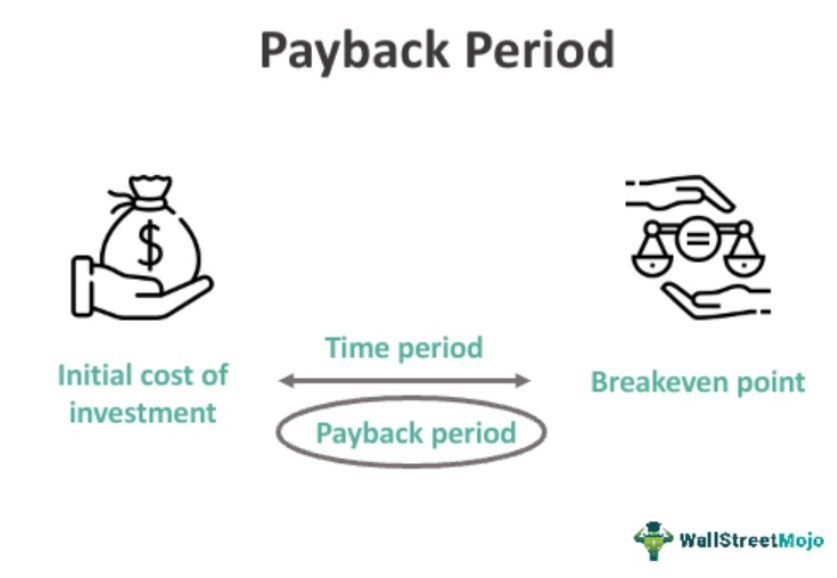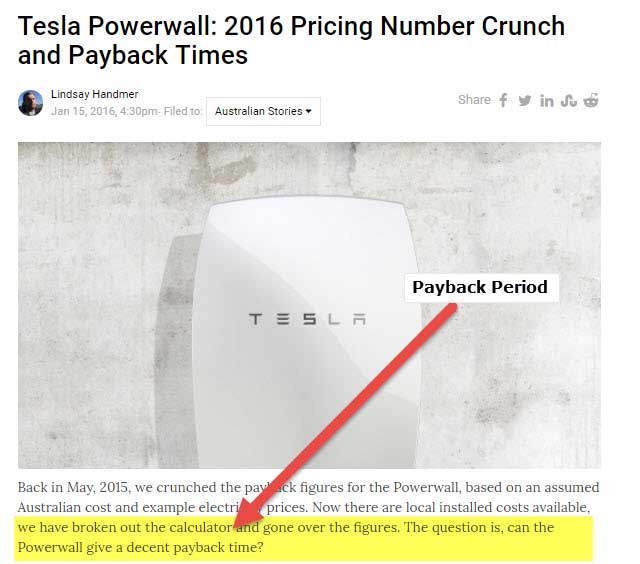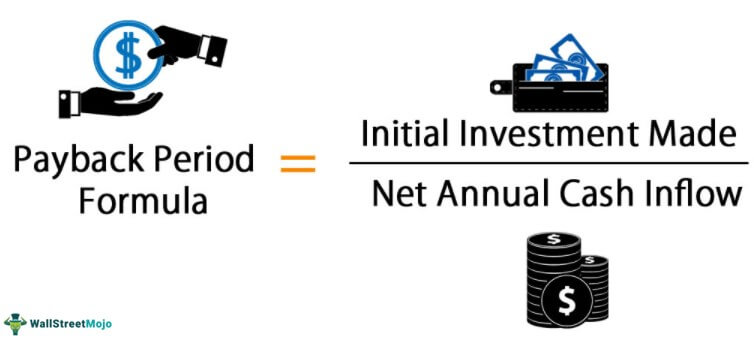What Is Payback Period?
Payback period can be defined as period of time required to recover its initial cost and expenses and cost of investment done for project to reach at time where there is no loss no profit i.e. breakeven point.

You are free to use this image on your website, templates, etc, Please provide us with an attribution linkHow to Provide Attribution?Article Link to be Hyperlinked
For eg:
Source: Payback Period (wallstreetmojo.com)
This is a method to check the viability of projects or investments. Here, if the payback period is longer, then the project does not have so much benefit. However, a shorter period will be more acceptable since the cost of the investment can be recovered within a short time. It is considered to be more economically efficient and its sustainability is considered to be more.
Table of contents
Payback Period Explained
The payback period is a metric in the field of finance that helps in assessing the time requirement for recovering the initial investment made in a project. It has a wide usage in the investment field to evaluate the viability of putting money in an opportunity after assessing the payback time horizon.
Every investor, be it individual or corporate will want to assess how long it will take for them to get back the initial capital. The shorter the period, the more favorable it is. This is because it is always worthwhile to invest in an opportunity in which there is enough net revenue to cover the initial cost.
Since the concept helps compute payback period with the breakeven point, the investor can easily plan their financial strategies further and make more decisions regarding the next step. It is calculated by dividing the investment made by the cash flow received every year. This is a valuable metric for fund managers and analysts who use it to determine the feasibility of an investment. However, it is to be noted that the method does not take into account time value of money.

source: Lifehacker.com.au
The above article notes that Tesla’s Powerwall is not economically viable for most people. As per the assumptions used in this article, Powerwall’s payback ranged from 17 years to 26 years. Considering Tesla’s warranty is only limited to 10 years, the payback period higher than 10 years is not idea.
Financial Modeling & Valuation Courses Bundle (25+ Hours Video Series)
–>> If you want to learn Financial Modeling & Valuation professionally , then do check this Financial Modeling & Valuation Course Bundle (25+ hours of video tutorials with step by step McDonald’s Financial Model). Unlock the art of financial modeling and valuation with a comprehensive course covering McDonald’s forecast methodologies, advanced valuation techniques, and financial statements.
Formula
The payback period formula is one of the most popular formulas used by investors to know how long it would generally take to recoup their investments and is calculated as the ratio of the total initial investment made to the net cash inflows. The below mentioned formula helps to compute payback period.

You are free to use this image on your website, templates, etc, Please provide us with an attribution linkHow to Provide Attribution?Article Link to be Hyperlinked
For eg:
Source: Payback Period (wallstreetmojo.com)
Explanation of Payback Period in Video
How To Calculate
- The first step in calculating the payback period is determining the initial capital investment and
- The next step is calculating/estimating the annual expected after-tax net cash flowsNet Cash FlowsNet cash flow refers to the difference in cash inflows and outflows, generated or lost over the period, from all business activities combined. In simple terms, it is the net impact of the organization's cash inflow and cash outflow for a particular period, say monthly, quarterly, annually, as may be required.read more over the useful life of the investment.
#1-Calculation with Uniform cash flows
When cash flows are uniform over the useful life of the asset, then the calculation is made through the following payback period equation.
Payback period Formula = Total initial capital investment /Expected annual after-tax cash inflow.
#2- Calculation with Nonuniform cash flows
When cash flows are NOT uniform over the use full life of the asset, then the cumulative cash flow from operationsCash Flow From OperationsCash flow from Operations is the first of the three parts of the cash flow statement that shows the cash inflows and outflows from core operating business in an accounting year. Operating Activities includes cash received from Sales, cash expenses paid for direct costs as well as payment is done for funding working capital.read more must be calculated for each year. In this case, the payback period shall be the corresponding period when cumulative cash flows are equal to the initial cash outlay.
In case the sum does not match, then the period in which it lies should be identified. After that, we need to calculate the fraction of the year that is needed to complete the payback.
Examples
Let us understand the concept of how to calculate payback period with the help of some suitable examples.
Example#1
Suppose ABC ltd is analyzing a project which requires an investment of $2,00,000 and it is expected to generate cash flowsCash FlowsCash Flow is the amount of cash or cash equivalent generated & consumed by a Company over a given period. It proves to be a prerequisite for analyzing the business’s strength, profitability, & scope for betterment. read more as follows
| Year Annual cash inflows | |
|---|---|
| 1 | 80,000 |
| 2 | 60,000 |
| 3 | 60,000 |
| 4 | 20,000 |
In this cash payback period can be calculated as follows by calculating cumulative cashflows
| Year | Annual cash inflows | Cumulative Annual cash inflows | Payback period |
|---|---|---|---|
| 1 | 80,000 | 80,000 | |
| 2 | 60,000 | 1,40,000(80,000+60,000) | |
| 3 | 60,000 | 2,00,000(1,40,000+60,000) | In this Year 3 we got initial investment of $ 2,00,000 so this is the pay back year |
| 4 | 20,000 | 2,20,000(2,00,000+20,000) |
Suppose, in the above case, if the cash outlay is $2,05,000, then pa back period is
| Year | Annual cash inflows | Cumulative Annual cash inflows | Payback period |
|---|---|---|---|
| 1 | 80,000 | 80,000 | |
| 2 | 60,000 | 1,40,000(80,000+60,000) | |
| 3 | 60,000 | 2,00,000(1,40,000+60,000) | |
| 4 | 20,000 | 2,20,000(2,00,000+20,000) | The payback period is between 3 and 4 years |
For up to three years, a sum of $2,00,000 is recovered, the balance amount of $ 5,000($2,05,000-$2,00,000) is recovered in a fraction of the year, which is as follows.
Forgetting $20,000 additional cash flows, the project is taking complete 12 months. So for getting additional of $ 5,000($2,05,000-$2,00,000) it will take (5,000/20,000) 1/4th Year. i.e., 3 months.
So, the project payback period is 3 years 3 months.
Example#2
Let us see an example of how to calculate the payback period equation when cash flows are uniform over using the full life of the asset.
A project costs $2Mn and yields a profit of $30,000 after depreciation of 10% (straight line) but before tax of 30%. Lets us calculate payback period of the project.
Profit before tax $ 30,000
Less: Tax@30%(30000*30%) $ 9,000
Profit after tax $ 21,000
Add: Depreciation(2Mn*10%) $ 2,00,000
Total cash inflow $ 2,21000
While calculating cash inflow, generally, depreciation is added back as it does not result in cash out flow.
Payback Period Formula = Total initial capital investment /Expected annual after-tax cash inflow
= $ 20,00,000/$2,21000 = 9 Years(Approx)
Advantages
Some important advantages of the concept of payback period in excel are as follows:
- It is easy to calculate.
- It is easy to understand as it gives a quick estimate of the time needed for the company to get back the money it has invested in the project.
- The length of the project payback period helps in estimating the project risk. The longer the period, the riskier the project is. This is because the long-term predictions are less reliable.
- In the case of industries where there is a high obsolescence risk like the software industry or mobile phone industry, short payback periods often become determining a factor for investments.
Disadvantages
Here are some disadvantages of the method. Let us study them in detail.
The following are the disadvantages of the payback periodDisadvantages Of The Payback PeriodPayback period is a very simple method for calculating the required period; it does not involve much complexity and aids in analyzing the project's reliability. Its disadvantages include the fact that it completely ignores the time value of money, fails to depict a detailed picture, and ignores other factors as well.read more.
- It ignores the time value of moneyTime Value Of MoneyThe Time Value of Money (TVM) principle states that money received in the present is of higher worth than money received in the future because money received now can be invested and used to generate cash flows to the enterprise in the future in the form of interest or from future investment appreciation and reinvestment.read more
- It fails to consider the investment total profitability (i.e. it considers cash flows from the initiation of the project until the payback period and fails to consider the cash flows after that period.
- It may cause the company to place importance on projects which are short payback period, thereby ignoring the need to invest in long-term projects( i.e, A company cannot just determine project feasibility only based on the number of years in which it is going to give your return back, there are number of other factors which it does not consider)
- It does not take into account the social or environmental benefits in the calculation.
Thus, the above are some benefits and limitations of the concept of payback period in excel. It is important for players in the financial market to understand them clearly so that they can be used appropriately as and when required and get the benefit of it to the maximum possible extent.
Payback Reciprocal
Payback reciprocal is the reverse of the payback period, and it is calculated by using the following formula
Payback reciprocal = Annual average cash flow/Initial investment
For example, a project cost is $ 20,000, and annual cash flowsAnnual Cash FlowsCash Flow is the amount of cash or cash equivalent generated & consumed by a Company over a given period. It proves to be a prerequisite for analyzing the business’s strength, profitability, & scope for betterment. read more are uniform at $4,000 per annum, and the life of the asset acquire is 5 years, then the payback period reciprocal will be as follows.
$ 4,000/20,000 = 20%
This 20% represents the rate of return the project or investment gives every year.
Payback Period Vs Return On Investment(ROI)
Both the above are important financial metrics used by analysts and investors to evaluate the profitability and viability of an investment. However, some differences between them are as follows;
- The former measures the time period whereas the latter measures the profitability of a project.
- The former measures how much time it will take for the initial investment to be recovered whereas the latter calulates the profit earning capacity compared to the cost of the opportunity.
- The former is focussed on the recovery whereas the latter is focussed on the return.
- The former takes into account the cash flows while making the calculation, but the latter takes into account the gains and losses from an investment.
- The former checks how much feasible a project is but the latter checks how well the resources are utilized.
Therefore the above points reflect the basic differences between the two financial concepts.
Payback Period Vs Discounted Payback Period
Both the above are financial metrics used for analysis and evaluation of projects and investment opportunities. But they differ in the technique used for calculation. Let us study the differences.
- The former is a method used to calculate how much time will be needed to recover the money invested in an opportunity initially. But the latter does the same using the discounted cash flow technique.
- The former does not account for the time value of money while the latter does so.
- Ideally, the time calculated by using the former is lower than the time calculated using the latter because the latter accounts for of calculates the current value of all the future cash flow.
- The investors and analysts prefer the latter to the former because of better clarity.
Thus, the above are some noteworthy differences between the two concepts.
Payback Period Video
Recommended Articles
Guide to what is Payback Period. We explain its formula, how to calculate, example, advantages, disadvantages & differences with ROI.
- Discounted Cash Flow FormulaDiscounted Cash Flow FormulaDiscounted Cash Flow (DCF) formula is an Income-based valuation approach and helps in determining the fair value of a business or security by discounting the future expected cash flows. Under this method, the expected future cash flows are projected up to the life of the business or asset in question, and the said cash flows are discounted by a rate called the Discount Rate to arrive at the Present Value.read more
- Incremental IRRIncremental IRRIncremental IRR or Incremental internal rate of return is an analysis of the return over investment done with an aim to find the best investment opportunity among two competing investment opportunities that involve different cost structures. As the costs of two investments are different, an analysis is done on the difference amount.read more
- Bank Rate vs Repo Rate DifferencesBank Rate Vs Repo Rate DifferencesThe Bank Rate is the interest rate charged by a central bank on loans and advances made to commercial banks without any security. In contrast, the Repo Rate is the rate at which the Central Bank lends money to commercial banks in case of a shortage of funds.read more
- Financing Acquisitions

